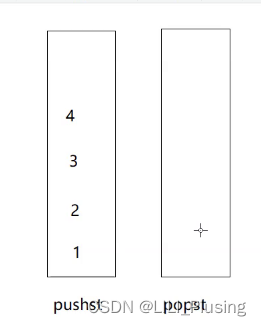
这里,队列的性质是先入先出,但是栈的性质是后入先出。两个队列就可以通过相互捯实现数据的后入先出。
typedef int QDataType;
//这是一个队列结点的结构
typedef struct QueueNode
{
struct QueueNode* next;
QDataType data;
}QNode;
//这是一个队列结构
typedef struct Queue
{
QNode* phead;
QNode* ptail;
int size;
}Queue;
//这是通过两个队列搭建的栈结构
typedef struct {
Queue q1;
Queue q2;
} MyStack;
//栈的初始化
void QueueInit(Queue* pq)
{
assert(pq);
pq->phead = NULL;
pq->ptail = NULL;
pq->size = 0;
}
//队列判空
bool QueueEmpty(Queue* pq)
{
assert(pq);
return pq->size == 0 ;
}
//栈数据个数
int QueueSize(Queue* pq)
{
assert(pq);
return pq->size;
}
//入队
void QueuePush(Queue* pq, QDataType x)
{
assert(pq);
QNode* newnode = malloc(sizeof(QNode));
if (newnode == NULL)
{
perror("malloc fail::");
return;
}
newnode->data = x;
newnode->next = NULL;
if (pq->ptail == NULL)
{
assert(pq->phead == NULL);
pq->phead = pq->ptail = newnode;
}
else
{
pq->ptail->next = newnode;
pq->ptail = newnode;
}
pq->size++;
}
//出队列
void QueuePop(Queue* pq)
{
assert(pq);
//队列为空
if(QueueEmpty(pq))
{
return NULL;
}
//当队列只有一个结点时,ptail会成为野指针,所以要分情况处理
if (QueueSize(pq)==1)
{
free(pq->phead);
pq->phead = pq->ptail = NULL;
pq->size = 0;
}
else
{
QNode* cur = pq->phead;
pq->phead = pq->phead->next;
free(cur);
cur = NULL;
pq->size--;
}
}
//获取队首元素
QDataType QueueFront(Queue* pq)
{
assert(pq);
if(pq->phead == NULL)
{
return NULL;
}
return pq->phead->data;
}
//队列的销毁
void QueueDestroy(Queue* pq)
{
assert(pq);
if(pq->size == 0) return;
if(pq->size == 1)
{
QueuePop(pq);
}
else
{
QNode* cur = pq->phead;
QNode* after = cur->next;
while (cur)
{
free(cur);
cur = after;
if (cur)
{
after = after->next;
}
}
pq->phead = pq->ptail = NULL;
pq->size = 0;
}
}
//队尾底元素的获取
QDataType QueueBack(Queue* pq)
{
assert(pq);
if (QueueEmpty(pq))
{
return NULL;
}
return pq->ptail->data;
}
//创建栈
MyStack* myStackCreate() {
MyStack *obj = (MyStack*)malloc(sizeof(MyStack));
if(obj == NULL)
{
perror("malloc fail::");
return;
}
QueueInit(&obj->q1);
QueueInit(&obj->q2);
return obj;
}
//压栈
void myStackPush(MyStack* obj, int x) {
assert(obj);
if (!QueueEmpty(&obj->q1))
{
QueuePush(&obj->q1,x);
}
else
{
QueuePush(&obj->q2,x);
}
}
//出栈
int myStackPop(MyStack* obj) {
assert(obj);
Queue* pEmptyQ = &obj->q1;
Queue* pNonEmptyQ = &obj->q2;
if(!QueueEmpty(&obj->q1))
{
pEmptyQ = &obj->q2;
pNonEmptyQ = &obj->q1;
}
while(QueueSize(pNonEmptyQ)>1)
{
QueuePush(pEmptyQ,QueueFront(pNonEmptyQ));
QueuePop(pNonEmptyQ);
}
int ret = QueueFront(pNonEmptyQ);
QueuePop(pNonEmptyQ);
return ret;
}
//获取栈顶元素
int myStackTop(MyStack* obj) {
assert(obj);
if(!QueueEmpty(&obj->q1))
{
return QueueBack(&obj->q1);
}
else
{
return QueueBack(&obj->q2);
}
}
//栈判空
bool myStackEmpty(MyStack* obj) {
return (QueueEmpty(&obj->q1) && QueueEmpty(&obj->q2));
}
//栈空间释放
void myStackFree(MyStack* obj) {
QueueDestroy(&obj->q1);
QueueDestroy(&obj->q2);
free(obj);
obj = NULL;
}

用栈实现队列就不能通过相互捯实现了,因为栈换到另一个栈中时,顺序就是相反的顺序,所以此时压栈顺序和出栈顺序就无法判断。
所以此时,我们将两个栈区分清楚,一个叫做“入”栈,专门用来进数据的,一个叫做“出”栈,专门用来出数据的。

此时要求出数据,若“出”栈内没有数据,则从“入”栈中捯过来,然后再出。若出栈中本来就有数据,则直接出栈即可。
要求入数据时,直接放在“入”栈中即可。
typedef int STDataType;
//栈的结点结构
typedef struct Stack
{
STDataType* a;
int top;
int capacity;
}ST;
//初始化栈
void STInit(ST* pst)
{
assert(pst);//如果指针为空,无法通过动态申请进行初始化,因为参数为一级指针。
pst->a = NULL;
pst->top = 0;
pst->capacity = 0;
}
//栈判空
bool STEmpty(ST* pst)
{
assert(pst);
/*if (pst->top == 0)
return true;
else return false;
*/
return pst->top == 0;
}
//销毁栈
void STDestroy(ST* pst)
{
assert(pst);
free(pst->a);
pst->a = NULL;
pst->capacity = 0;
pst->top = 0;
}
//压栈
void STPush(ST* pst,STDataType a)
{
if (pst->top == pst->capacity)
{
int newCapacity = pst->capacity == 0 ? 4 : 2 * pst->capacity;
STDataType* tmp = (STDataType*)realloc(pst->a, newCapacity * sizeof(STDataType));
if (tmp == NULL)
{
perror("realloc fail::");
return;
}
pst->a = tmp;
pst->capacity = newCapacity;
}
pst->a[pst->top] = a;
pst->top += 1;
}
//出栈
void STPop(ST* pst)
{
assert(pst);
assert(!STEmpty(pst));
pst->top--;
}
//获取栈顶元素
STDataType STTop(ST* pst)
{
assert(pst);
assert(!STEmpty(pst));
return pst->a[pst->top - 1];
}
//栈元素个数统计
int STSize(ST* pst)
{
assert(pst);
return pst->top;
}
//由两个栈构建的队列结构
typedef struct {
ST pushst;
ST popst;
} MyQueue;
//队列的创建
MyQueue* myQueueCreate() {
MyQueue * obj = (MyQueue*)malloc(sizeof(MyQueue));
if(obj == NULL)
{
perror("malloc fail::");
return;
}
STInit(&obj->pushst);
STInit(&obj->popst);
return obj;
}
//入队
void myQueuePush(MyQueue* obj, int x) {
assert(obj);
STPush(&obj->pushst,x);
}
//出队
int myQueuePop(MyQueue* obj) {
assert(obj);
int ret = 0;
if(!STEmpty(&obj->popst))
{
ret = STTop(&obj->popst);
STPop(&obj->popst);
}
else
{
while(STSize(&obj->pushst))
{
STPush(&obj->popst,STTop(&obj->pushst));
STPop(&obj->pushst);
}
ret = STTop(&obj->popst);
STPop(&obj->popst);
}
return ret;
}
//获取队首元素
int myQueuePeek(MyQueue* obj) {
assert(obj);
if(!STEmpty(&obj->popst))
{
return STTop(&obj->popst);
}
else
{
while(STSize(&obj->pushst))
{
STPush(&obj->popst,STTop(&obj->pushst));
STPop(&obj->pushst);
}
return STTop(&obj->popst);
}
}
//队列判空
bool myQueueEmpty(MyQueue* obj) {
assert(obj);
return (STEmpty(&obj->pushst)&&(STEmpty(&obj->popst)));
}
//释放队列空间
void myQueueFree(MyQueue* obj) {
STDestroy(&obj->popst);
STDestroy(&obj->pushst);
free(obj);
obj=NULL;
}





















 1968
1968











 被折叠的 条评论
为什么被折叠?
被折叠的 条评论
为什么被折叠?








